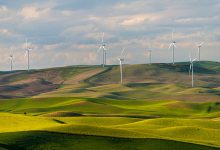The Western Australian government is about to embark on an ambitious investment to replace its last two publicly-owned coal generators with wind, solar and battery storage – enough to take the state’s main grid – the biggest isolated grid in the world – to 70 per cent renewables.
Earlier this week, Western Australian energy minister Bill Johnston unveiled a plan to invest $3.8 billion in new projects before the end of the decade, to build the capacity needed to replace the soon to be closed Muja and Collie coal fired power station.
The investment – which will be managed by government-owned utility Synergy – is expected to deliver upwards of 800MW of new wind generation capacity and more than 1,100MW of new energy storage capacity – the latter to consist mostly of big battery projects.
It would mark an almost doubling of WA’s wind generation capacity, which currently sits at around 1,000MW, and a substantial increase to the state’s energy storage capacity.
Synergy is currently developing a 100MW/200MWh ‘big battery’ project at the site of the Kwinana Power Station, expected to be operational by the end of this year.
Alinta also has a proposal for a big battery near the Wagerup refinery, but apart from existing and proposed big batteries in the Pilbara, a separate grid, Western Australian main grid does not feature any large scale battery projects.
Synergy says the specific details of the future renewable energy and storage projects are yet to be finalised, but will almost certainly involve the roll out of a number of additional battery projects, potentially repurposing infrastructure at the Muja and Collie power stations – similar to a proposal put forward by Ross Garnaut’s Sunshot Energy.
The WA government expects that by the end of the decade, the state will host as much as 4,400MW of energy storage capacity, when other energy storage projects, community battery projects and residential battery systems are accounted for.
This could include the state’s first pumped hydro energy storage project – with the WA government understood to be aiming for between 400 and 800MW of pumped hydro capacity – with Synergy to kick-start a feasibility study.
Under the plan announced on Tuesday, the 340MW Collie power station will close in 2027. The last two remaining units of the 1,100MW Muja power station – the C and D units – will close in 2024 and 2029, respectively.
Johnson says the viability of the two coal fired power stations is becoming eroded by strong growth in renewables uptake, particularly in rooftop solar, and it not longer made sense to prop up the generators.
Just over a third of WA households – around 400,000 in total – currently have solar installed with a combined capacity of more than 1,350MW. The state government expects uptake will grow until 2030 and beyond, with more than half of all WA households set to feature rooftop solar by 2030.
A new planning report by the Australian Energy Market Operator released on Friday predicts “distributed solar”, which includes household rooftop solar mentioned above, commercial solar and small PV plants, will grow by at least 240MW a year from 2.2GW to more than 4.5GW in ten years.
The growth in distributed solar, and the government’s active investment in new large-scale solar, wind and storage projects will help the state reach 70 per cent renewables by 2040, with the remainder largely provided by gas generation.
That share of renewable energy generation represents a doubling of the state’s renewables share, and may disappoint some energy activists who say a faster and bigger switch to renewables is possible.
Interestingly, the commitment to close the Collie and Muja power stations mirrors the commitments taken to the last state election by the former WA Liberal leader Zak Kirkup.
In an effort to shake up the election, Kirkup announced an ambitious plan to close the two power stations by 2025, and to replace them with expansive investments in replacement renewables and storage.
The Liberal party plan was even a bit too ambitious for the incumbent Labor government, which labelled it “risky”. Unfortunately for Kirkup, the policy gamble didn’t pay off, with the WA Liberals almost entirely wiped out at the 2021 election – winning just two seats.
In addition to the $3.8 billion spend on new electricity infrastructure announced on Tuesday, the decommissioning of the two coal generators is expected to cost the WA government $300 million on rehabilitation works.
Johnston says the state government expects to engage local workers and business from within the Collie region to undertake the dismantling works, while it will also provide additional funding to establish new industries and economic opportunities in the region.
“Our Government is squarely focused on making sure there continues to be high quality, well-paid local jobs in the kinds of heavy industries the Collie region is known for,” Johnston said.
“Along with coordinated power station decommissioning works and new industrial projects, this program will provide new opportunities for blue collar workers from Collie and surrounding regions.”










